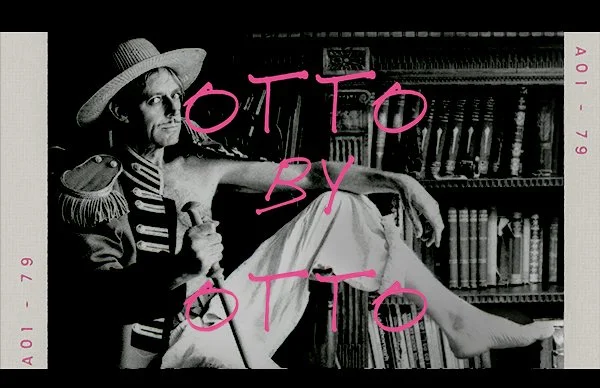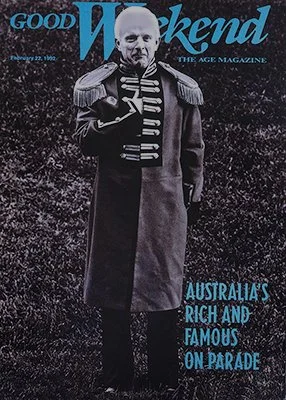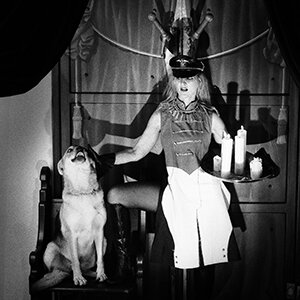Kylie Minogue, 1987
THE SALUTE STORY (abridged)
Peter Carey, c. 1987
Barry Humphries, c. 1988
In 1986, at 26, Sydney fashion photographer Stuart Spence was burnt out. The fashion press at the time (mostly) prioritised garments over personality, and this just didn’t sit quite right with Spence. As luck would have it, the magazine he worked for had started running long-form personality pieces, and Spence shifted seamlessly into portraiture. Little did he know that this shift would instantly gain him access to some of the most iconic figures swirling around the zeitgeist at the time. Spence suddenly found himself capturing the vibrant, excessive, self-possessed, cult-of-personality of the 80s.
Shooting for the magazine with such a fascinating coterie of well-known folk, Spence began thinking of a portrait series of his own. He felt a unifying concept might be an interesting way of exploring an individual’s unique way of being in the world. Over the next six years, utilising a single military jacket as a recurring prop (military fashion was very popular in 80’s) Spence created Salute, a 90-portrait series capturing one of Australia’s most eclectic and bold cultural times through the lens of individuality and collaboration.
THE COLLECTION
Title frame from feature documentary ‘Otto by Otto,’ currently streaming on Stan
THE SALUTE STORY (unabridged)
Now and then, someone will ask me if Salute was a direct reference to British colonisation, and I always look at them aghast. When I started shooting this series in 1986, such a reference couldn’t have been further from my mind. Any military overtones the jacket possessed were only there to stimulate my subjects’ imaginations, that was it. If a sitter chose to respond to it in a negative way, and a few did, it was only as a reaction to the horror of war. Let’s not forget the Cold War was still hanging around in ‘86; Sri Lanka, Guatemala, Iran and Iraq were all warring, so it seemed perfectly logical to me that some of my subjects might react this way.
In the early 80’s, the ‘military look’ was all the rage, with Madonna, Michael Jackson, Duran Duran and Adam Ant (and many more) all getting in on the act. All borrowed, tarted up and pranced their ‘re-imagined’ armed forces garb on the cover of every magazine, newspaper, and in close-up on the new TV explosion that was MTV.
The military movement hadn’t escaped me, either.
Over those years, I found myself photographing a plethora of Australian designed, military fashion ...a sparkly epaulet here, some gold braiding there, sometimes whole outfits would almost be dedicated to a particular army, Stuart Membery’s Chairman Mao line comes to mind. They were vibrant and graphic and fun to shoot, and, like probably the most famous of pop-culture military jackets, the Beatles’ Sergeant Pepper’s Lonely Hearts Club Band, it could be shaped into any cosmically-coloured ideology a designer could dream up.
And of course, there was the wonderful anarchy of re-imagining our defence forces as fashion opportunities.
Naughty!
But I’m getting ahead of myself.
In the early 80's I was one beleaguered, worn-down fashion photographer. I worked full time on an Australian broadsheet style magazine, as its sole staff photographer. I was not suited to this, it almost sent me loco, but that’s whole other story.
Fashion shoot, Noumea
Salute's inception took place on one of the various overseas shoots I would cover each year. In 1986, I found myself at Club Med, Noumea. After another day of back-breaking slog, dealing with contrary models fainting from diet abuse, disobedient tropical weather and, of course, school boy French challenges, by nightfall, I was well and truly exhausted. As a rule, however, I have always made a deal with myself that, no matter where I am in the world, no matter how fatigued, I will always experience something of the place where I’m working. Otherwise, I figured, what’s the point?
One evening, sitting at the back of the Club Med auditorium, blearily watching a cheesy stage show featuring the Club’s guests, I witnessed three men from different parts of the world draw elephants on large sheets of cardboard. Upon the drawings completion, each hapless artist’s wife was set the task of geeing up the crowd in support for their man’s artwork, in the hope of sending a clap-o-meter off the scale and thus winning a prize. Tragic stuff, sure, but when the grand reveals finally happened, a bolt from the heavens struck my weary head, a Eureka moment exploding from the world’s worst stage show.
The three elephants were spun around and displayed to the audience, and there they were, tiny and disfigured, surreally cubist, enormous and cartoony, One man had completely filled the paper space, another had only used a minute section. Each artist had drawn with a hand completely unlike the fella next to him, some in deft clean lines, some crooked and unsure. Their grand unveiling was met by little, or no response.
Except from me.
I’d never imagined drawing an elephant could show so much about a person. These guys looked like me, talked like me, even dressed like me (kind of) and yet judging by their artworks, they could have been from different planets.
So, Salute was born.
My days of shooting fashion were suddenly nearing their end. The writing was on the wall.
Chris Murphy, criminal lawyer, 1989
As well as my fashion assignments, I’d started shooting the odd celebrity portrait for the magazine. This was the heady 80’s when Rene Rivkin actually was Gordon Gecko, when money flowed down George Street like molten gold, lunches lasted days, and the pointy end of town could say and do just about any bloody thing they wanted. Responding to the laissez-fair zeitgeist, I began suggesting more unusual portrait ideas to my high-flying subjects. Heavy-hitting criminal barrister, Chris Murphy, comes to mind, up to his waist in a rooftop swimming pool clad in a three piece pin-striped suit and goggles. I figured, at this moment in history, to talk Australia’s 'A' list into frocking up and poncing around for my camera would be a cinch. And I was right. These were look-at-me-days, and I wanted in, but I wanted it on my terms, not in the pages of a magazine. I wanted my own series.
The problem was, like the elephant art project, I needed something to unify my subjects.
I’d always wanted a photographic prop that had its own inherent, built in, theatricality. This prop needed to be a kind of emotional 'short cut' that could elicit an instant reaction from subjects with often little or no time for deep and meaningful photographic explorations. After all, there was lunching to be done, for heaven's sake!
Me…embarrassingly
Every year one magazine or another would run a ‘little black dress’ series, with designers re-interpreting that classic wardrobe staple in a style of their own. This interested me, and initially I flirted with the idea of using a classic black suit as the unifying prop for my series, but eventually decided against it. Black was hard to photograph without it turning into a black blob, and there just wasn’t enough inbuilt nuance. I didn’t think there were enough narratives running through a black suit to allow my sitters to explore different psychological angles.
I think I may have been in Singapore shooting a fashion spread for Mode magazine when during a sweltering afternoon one of the models emerged wearing a beret and long black coat with gold military trimmings, and voila, the penny dropped. It wasn’t so much an earth-shattering moment, so much as the zeitgeist simply breathing me in, and me gladly surrendering.
In 1986 I installed myself in North Sydney Library, and after a day or two, walked out with a sort of identikit cut and pasted picture of the jacket that would, for the next 5 years, be my photographic companion. With a few bright buttons and some gold epaulets, and with the enlistment of the now defunct Elizabethan Theatre Trust’s costume department, my bright red Frankenstein’s creation was brought to life.
John Button, Labor politician
As my magazine portrait assignments became more frequent, so I would start bringing the jacket along to shoots. Riding on the wave of élan produced at the end a good photo shoot, I'd casually reveal the jacket as we were finishing up, “Hey, look, just before you go,…” As time went on, and armed with black and white portraits of those who had donned the jacket before them, the vast majority of people would agree to join in on the spot. "Well, if so-and-so's done it, I simply must."
As a photographic collection, the jacket has been a great unifier, but it’s as a psychological exercise, albeit a strictly amateur one, that I think the portraits work best.
Bruce Spence, actor
Like the Club Med artists, so my subjects all had their own unique take on interpreting the jacket. Some simply saw it as a kind of Sergeant Pepper loud fashion statement, others took it more seriously. The wonderful actor, Bruce Spence, took a firm anti-war stance, and created a theatrical scene for his portrait. In it he plays a soldier gone AWOL, who, upon arriving home, and promptly disposing of his uniform in the rubbish bin, realises he's been caught out when he checks the mail.
The artist and bondage mistress, Madame Lash, aka Gretel Penniger, decided that she would not use the actual jacket, but interpret it with a garment of her own with similar military lines. Why she wanted to accessorise with a tray of candles and her German shepherd was hard to tell, but who was I to interfere? These portraits were about my subjects, after all.
Gretel Penniger, artist, performer
I was never interested in those PR-friendly, phony smiles, or the James Bond suave smirks. The press was (and still is) spilling over with that nonsense. Hopefully, the Salute series has enabled us outsiders a tiny peek past those glossy, celebrity patinas. I like to think the jacket giving license to a publicity-battered, elite group to take some of the heat off, to draw focus for a second and allow them just to be whatever the hell they wanted.
How do I know this?
Simple. The look on my subjects faces when I brought out the old suit bag and revealed the jacket. It sounds terribly corny, but it always felt like they were discovering some wonderful story for the first time, Peter Pan, perhaps (Barry Otto certainly did). Some would take it in with quiet awe, others with sheer delight, but always, something sparked.
Kylie Minogue, entertainer
Most of my job was pretty well done at this stage, the rest was just playing dress ups with 9 year olds.
So many 9-year olds come to mind from that time.
I have a vivid memory of waiting nervously backstage at Channel 7 (for an eternity) in 1988. Finally, a miniscule figure, surrounded by a clutch of serious record company types, strolled in, picked up the jacket, took a quick look, then began flinging it this way and that around the studio. Kylie Minogue had just released her first single, Locomotion, and was probably still appearing in Neighbours at the time.
In 1989, Nicole Kidman wasn't a well known actress. When we met at her Mosman flat (above a dress shop) I had no idea that the lengthy phone call she took while I waited was from Phil Noyce offering her the lead in Dead Calm. She was very happy on my shoot that day down on the rocks at Balmoral Beach, a feature film just squared away in her mind.
Brett Whiteley, artist
And who were those guys in their underpants and work boots helping Brett Whiteley prepare one of the exquisite twig nests for his bird series in 1986? There was Paul Kelly blaring through the studio sound system, Brett flitting around, ciggie in hand, directing the lads drilling the twigs in, like a busy bower bird himself?
Promotional poster for the feature documentary “Whiteley’
And so on.
The collection is a slice of time in Australia when big hair, big bucks and shonky business ruled the land with a sequin crown. When the well-to-do took risks unheard of in today’s climate of economic justification, bottom-line politics and impenetrable Public Relations personnel. Salute is a celebration of a group of Australians, some important (whatever that means) others just plain fascinating, who were wonderful enough to come along for a ride with me and my jacket and help me have some of the best fun I’ve ever had as a photographer.
It really is just one big Salute to a crazy time, and to the guests who were the last to leave the party.
Stuart Spence, 2023














































































































